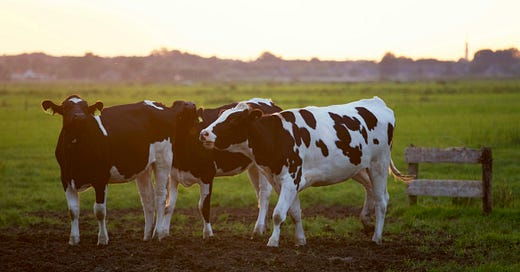H5N1: Are Dairy and Beef Industries Gambling with Public Health? Assessment of the $200 Million Plan to Contain Bird Flu in Cows
Cows possess receptors for both human and bird flu, raising the risk of the virus evolving to infect humans more effectively, potentially leading to human-to-human transmission.
As the dairy and beef industries continue to flourish, recent revelations suggest a serious threat is on the verge of emerging. With milk and dairy products ranking as the fourth largest agricultural commodity in the US and cattle and calf sales securing the second position, attention turns to the possible consequences of neglecting public health in pursuit of profit. Amidst growing concerns about the spread of H5N1 bird flu to humans and its potential implications, questions arise regarding the industries' priorities: are financial interests overshadowing efforts to protect public health from the looming threat of another global pandemic?
Furthermore, a recent study has uncovered unsettling findings indicating that both dairy and beef cows serve as potential hosts for the Avian and Human Influenza A Virus. This study reveals that receptors for these viruses are expressed in various regions of cows' bodies, including the mammary glands, respiratory tract, and brain. This revelation raises alarming concerns about the possibility of these animals becoming reservoirs for viral transmission and the potential emergence of new variants with increased human infectivity.
Is the Dairy and Beef Industry Prioritizing Profit Over Protecting Public Health?
In 2022, milk and dairy products ranked as the fourth largest agricultural commodity in the US based on cash receipts, as reported by the USDA's Economic Research Service. Furthermore, cattle and calf sales ranked as the second largest commodity. While there may be a clear motive to conceal the scale of H5N1 infection, the question arises: are financial interests clouding judgment, potentially endangering billions of lives with the prospect of another global pandemic?
To address these concerns, the industry should collaborate with the CDC and USDA by voluntarily implementing random sample testing for both cows and farm workers. This proactive approach would not only help restore public confidence but also involve the creation of a dashboard displaying the numbers of symptomatic and asymptomatic infections among farm workers. Additionally, it should establish a transparent quarantine procedure ensuring continuous worker compensation during the quarantine period.
Cows Have Human and Bird Flu Receptors, Increasing the Odds of it Evolving to Infect Humans More Efficiently, Potentially Leading to Human-to-Human Transmission
The bird flu virus’s key binding receptor is a sugar molecule known as a sialic acid receptor. Birds have sialic acid receptors shaped differently from those in humans' upper respiratory tracts, which explains why bird flu has limited transmission among humans. However, recent research has unveiled that cows possess both types of sialic acid receptors, a surprising discovery that raises concerns about the potential for the bird flu virus to adapt to humans in cows.
A study published on May 3, 2024, which we will get into in more detail below found that these receptors were present in the highest numbers in the mammary gland, but also in the respiratory tract, and cerebrum (brain) of both beef and dairy cows. This suggests that not only are dairy cows susceptible, but also beef cows. Although these receptors were found in the highest concentrations in the tiny milk-producing sacs of the udder, called alveoli, they were also found in the respiratory tract and the brain. If it can infect the respiratory tract then airborne transmission via exhaled air is also possible. Furthermore, it shows that like the dolphin and likely the cats, H5N1, can infect the brains of cows. The question remains, if it were to adapt to humans, could it infect human brains?
The First Dolphin Confirmed with H5N1 Died With Highest Viral Load in the Brain
“Pathological findings include neuronal necrosis and inflammation of the brain and meninges, and quantitative real-time RT-PCR reveal the brain carried the highest viral load.” (1)
Flu viruses can evolve through a process called reassortment, wherein a cell infected with different flu strains can produce hybrid variants. The revelation that cows harbor both bird and human flu receptors implies the possibility of reassortment events occurring within these animals. This phenomenon mirrors past pandemics caused by pigs, which also carry both types of receptors and have served as hosts for flu virus reassortment before, leading to viruses capable of efficient human-to-human transmission. For instance, the 2009 pandemic triggered by H1N1 influenza is thought to have originated in pigs in Mexico, where the virus underwent reassortment, enabling it to rapidly spread among humans.
There is another path it can take to evolve to more easily infect humans. The second path involves gradually adapting to bind more effectively to human receptors within cows, creating a mutation that could increase the virus's ability to infect humans.
The Avian and Human Influenza A Virus Receptors are Expressed in Cows’ Mammary Glands, Respiratory Tract, and Brain
Here’s a more precise breakdown of the pre-print study published May 3, 2024. Bird flu receptors on host cells are essentially sugars called sialic acids (SAs) linked to galactose in specific ways: either in an α2,3 or α2,6 pattern. Human flu viruses mostly like to attach to SA-α2,6 (known as the human receptor), while bird flu viruses prefer SA-α2,3 (the bird receptor). Within the bird receptor, there are two types: one that chicken flu viruses prefer, called SA-α2,3-Gal-β1,4 (chicken receptor), and another that duck flu viruses prefer, known as SA-α2,3-Gal-β1,3 (duck receptor).
In their study, they found that all these receptors were present in the mammary gland, respiratory tract, and cerebrum (brain) of both beef and dairy cows, though they varied in how much they were present. The receptors that duck and human flu viruses like were quite common in the mammary gland of cows, while the chicken receptor was more common in the respiratory tract. They also noticed that neurons in the brain had low levels of these receptors.
The findings suggest that cows could potentially become a hotspot for the H5N1 bird flu virus, potentially becoming a reservoir for this virus. Additionally, since cows have receptors for both bird and human flu viruses, they could mix these viruses inside them, or allow for an evolutionary jump, possibly creating new variants of H5N1 that could more easily spread to humans.
Assessment of the Biden Administration $200 Million Plan to Contain Bird Flu in Dairy Cows
The Biden administration has announced a plan to allocate nearly $200 million to combat the spread of avian flu among dairy cows. This initiative aims to contain outbreaks and address concerns about human infections with the H5N1 virus. Here are the key points of the plan:
Funding Allocation:
The U.S. Department of Agriculture (USDA) will make $98 million available to provide financial support to dairy farms. Each farm can receive up to $28,000 for efforts to contain the virus spread between animals and humans. This includes testing milk and animals for the virus.
The Department of Health and Human Services (HHS) will contribute $101 million through the FDA and U.S. Centers for Disease Control and Prevention (CDC) to protect public health and the nation’s food supply.
The FDA will allocate $8 million to ensure the safety of the commercial milk supply although the details haven’t been disclosed.
The money includes $34 million through the CDC for testing efforts and supporting public health labs, $8 million for vaccines, and $3 million for wastewater surveillance.
Risk Assessment:
While the CDC has emphasized low public health risk, there remain a lot of unanswered questions.
The outbreak is likely more widespread based on U.S. Food and Drug Administration findings of H5N1 particles in about 20% of retail milk samples.
The initial testing didn’t find viable virus but it was a small sample size and we are still awaiting larger study results
The USDA declared all beef is safe after testing just 30 beef samples bought in stores near the dairy farms that had outbreaks. We are awaiting results from muscle samples of dairy cows being killed and used for meat.
The initiative is focused on dairy cows, but as shown in the study above, it is very likely impacting beef cows as well. They need to quickly expand testing to include all beef cows.
They are not testing farm workers. They must implement mandatory random testing of farm workers to quickly isolate these cases and prevent any potential transmission in humans.
Testing Requirements:
To limit transmission in cattle, the USDA on April 29 started requiring lactating dairy cows to test negative before being shipped across state lines.
In the first week of the order, USDA laboratories reported 905 tests, of which 112 were presumptive positives, said an agency spokesperson.
The order is for “lactating” dairy cows, leaving out non-lactating dairy cows, calves, and beef cows. These are huge gaps and they need to be closed immediately.
TACT’s Overview
Given the most recent data, it's imperative to intensify efforts to contain bird flu transmission among dairy and beef cows and enhance protective measures for workers handling cows and milk products to mitigate potential public health risks.
The discovery of 112 positive lactating dairy cows within the first week of testing highlights the critical need for immediate action. Delaying the implementation likely resulted in several hundred infected cows spreading to new herds This was a colossal mistake. The fact that they aren’t testing beef cows, calves, or non-lactating dairy cows is another massive failure. This was predictable before the study highlighted here, but now that we have the science showing that H5N1 can very likely infect all cows, the order should be expanded immediately.
We need to randomly test both dairy cows and beef cows consistently and we need to implement mandatory random testing of the farm workers. We need to stress the importance of what’s occurring to the families of farm workers. If any of the families are willing to help protect all of humanity from another pandemic, then we should be randomly testing them as well.
The industry should collaborate with the CDC and USDA by voluntarily implementing random sample testing for both cows and farm workers. This proactive approach would help restore public confidence. To further enhance transparency they could create a public online dashboard, updated weekly, displaying the numbers of symptomatic and asymptomatic infections among cows and farm workers. Additionally, they should establish a transparent quarantine procedure for cows and for farm workers, ensuring continuous worker compensation during the quarantine period.
While the Biden administration's allocation of $200 million towards containing the virus is a step in the right direction, its focus solely on dairy cows overlooks the high likelihood of beef cows being affected as well. With the virus's potential evolution to facilitate easier spread to humans and subsequent human-to-human transmission, prompt and comprehensive containment efforts are imperative. Every day the government and the dairy and beef industries delay necessary actions, the risk of another pandemic escalates. This is predictable. This is preventable.
By subscribing, you’re helping support:
Unbiased reporting: We cut through the noise and deliver critical information you need to make informed decisions about your health.
In-depth analysis: TACT goes beyond headlines to uncover details and the true impact of COVID, Bird Flu, Monkeypox, and other emerging or evolving diseases.
Empowering insights: We translate complex scientific data into actionable knowledge, putting you in control of your well-being.
Support Independent Journalism - Become a Paid Subscriber Today!








In case you were wondering, the USDA is basically a subsidiary of the National Cattleman's Beef Association.
On an unrelated topic, I am seeing a lot of reporting today on the SARS-CoV-2 variant KP.2.
Seems like a focus on the wrong bogey. KP.3 will almost certainly outcompete it. In a previous post, you introduced me to other nasty variants. Right now, what are your favorite 'Variants Under TACT Monitoring'? KP.3 seems to be cooking in Australia.
Oh...by the way, 'Mad Cow Disease' has turned up in Scotland.